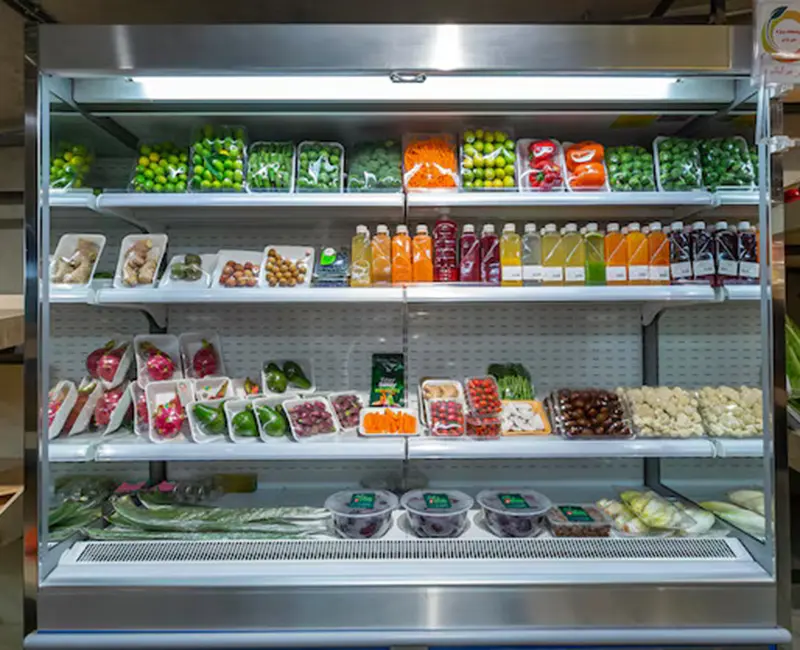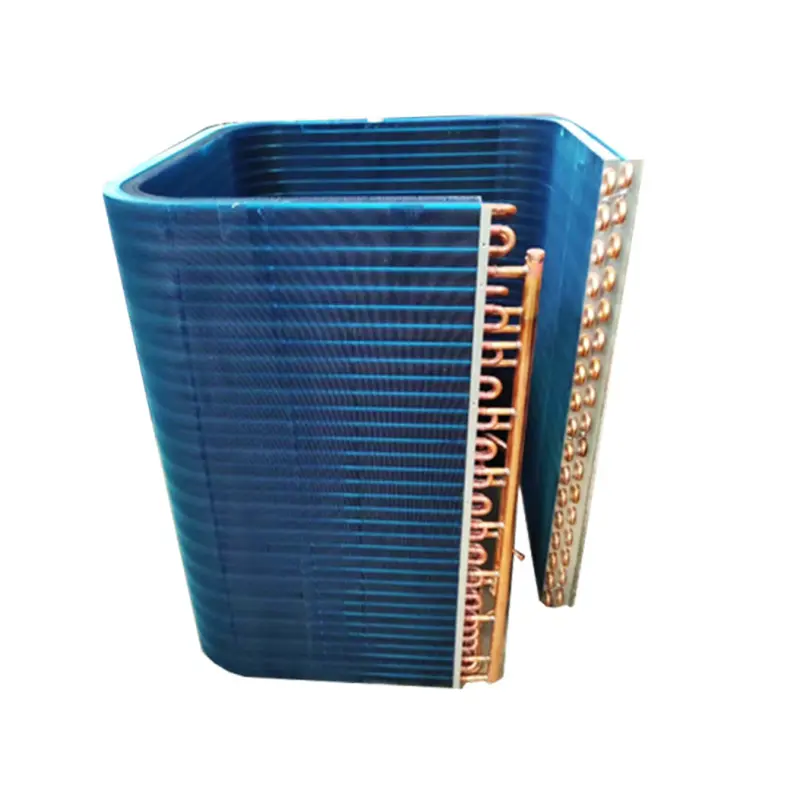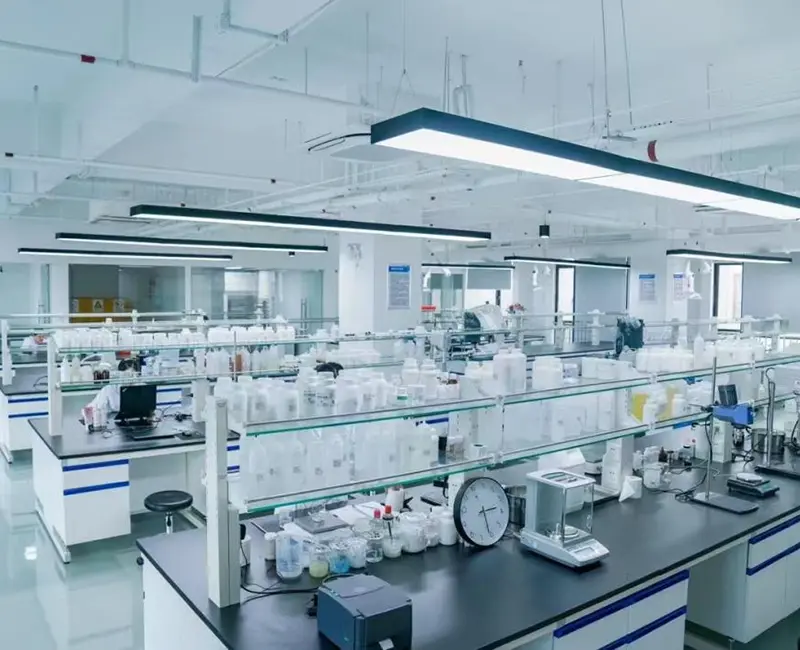What is the difference between copper tube and aluminum fin heat exchangers compared to other types?

When comparing copper tube and aluminum fin heat exchangers to other types, the material properties stand out as a key differentiator. The exceptional thermal conductivity of the Copper Fin Heat Exchanger allows these exchangers to achieve superior heat transfer efficiency. For instance, studies show that copper tube exchangers outperform aluminum tube designs by 4%-12% in heat transfer and 7%-9% in heat transfer coefficient under varying wind speeds. This makes them a reliable choice for applications requiring high performance.
Choosing the right heat exchanger involves more than just performance. Cost, durability, and application suitability play critical roles. Every application has unique requirements, and selecting the wrong type can lead to inefficiencies or increased maintenance. Balancing factors like lifespan, efficiency, and safety ensures the best fit for your needs.
Key Takeaways
- Copper tube and aluminum fin heat exchangers transfer heat better. They work 4%-12% more efficiently than all-aluminum designs. This makes them great for high-performance uses.
- Think about the long-term benefits of heat exchangers. Copper-aluminum ones cost more at first but last longer. They save money on repairs and replacements over time.
- Cleaning and checking heat exchangers often can make them last longer. This keeps them working well and reduces repair needs.
- Copper does not rust easily, even in tough places like near the ocean. This makes these heat exchangers strong and reliable.
- When picking a heat exchanger, think about heat transfer, weight, and how you will use it. This helps you choose the right one.
Material Properties

Thermal Conductivity
When I think about heat exchangers, thermal conductivity is the first property that comes to mind. It determines how well a material transfers heat. Copper and aluminum, the two primary materials in copper tube and aluminum fin heat exchangers, excel in this area. Copper, with a thermal conductivity of up to 413 W/m·K, outperforms aluminum, which has a maximum value of 237 W/m·K. Here's a quick comparison:
| Material | Thermal Conductivity (W/m·K) |
|---|---|
| Copper | 413 |
| Aluminum | 237 |
| Titanium | 24 |
| Stainless Steel | Low teens |
This difference explains why copper-based heat exchangers transfer heat 4%-12% more efficiently than aluminum ones under identical conditions. However, aluminum's lower cost and density make it a practical choice for many applications.
Corrosion Resistance
Corrosion resistance is another critical factor I consider when evaluating materials. Copper and aluminum both form protective oxide layers, but they behave differently over time. Copper develops a patina that shields it from further damage, making it ideal for long-term use in harsh environments. Aluminum also resists corrosion well, especially in outdoor or marine settings, but it can be more vulnerable to galvanic corrosion when in contact with other metals. For marine applications, copper alloys show impressive durability, with corrosion rates as low as 1.3 x 10^-4 mm/year.
Weight and Structural Strength
Weight and strength often go hand in hand. Aluminum is much lighter than copper, with a density of 2712 kg/m³ compared to copper's 8940 kg/m³. This makes aluminum a preferred choice for lightweight designs. However, copper's higher tensile strength (200–350 MPa) gives it an edge in durability and resistance to mechanical stress. It deforms less under constant pressure, making it suitable for demanding applications like automotive components and power systems.
| Material | Density (kg/m³) | Tensile Strength (MPa) |
|---|---|---|
| Copper | 8940 | 200–350 |
| Aluminum | 2712 | ~100 |
Performance Metrics
Heat Transfer Efficiency
When I evaluate heat exchangers, heat transfer efficiency is one of the most critical factors. Copper tube and aluminum fin heat exchangers excel in this area. Copper's superior thermal conductivity allows it to transfer heat more effectively than other materials. For example, copper tube exchangers consistently outperform aluminum tube designs by 4%-12% in heat transfer under varying wind speeds. This advantage comes from copper's ability to conduct heat rapidly, while the aluminum fins increase the surface area for heat dissipation. Together, they create a highly efficient system.
| Condition | Copper Tube-Aluminum Fin | Aluminum Tube-Aluminum Fin |
|---|---|---|
| Heat Transfer Coefficient | Higher | Lower |
| Thermal Conductivity | Superior | Inferior |
| Heat Transfer Area | Same | Same |
This combination makes copper tube and aluminum fin heat exchangers a reliable choice for applications requiring consistent and efficient heat transfer.
Maintenance and Cleaning
I always consider maintenance when choosing a heat exchanger. Copper tube and aluminum fin heat exchangers require less frequent maintenance due to copper's natural resistance to corrosion. Unlike aluminum, which is more prone to pitting and galvanic corrosion, copper forms a protective layer that shields it from environmental damage. This durability reduces the need for repairs and extends the lifespan of the system. Cleaning is also straightforward, as the smooth surfaces of copper tubes resist buildup. However, I recommend regular inspections to ensure optimal performance, especially in environments with chemical contaminants.
Energy Efficiency
Energy efficiency directly impacts operational costs. Copper tube and aluminum fin heat exchangers stand out for their ability to transfer heat efficiently, which reduces energy consumption. Copper's high thermal conductivity ensures rapid heat transfer, while aluminum fins enhance the overall efficiency by dissipating heat effectively. Compared to aluminum tube exchangers, copper tube designs achieve 7%-9% higher heat transfer coefficients. This means less energy is required to achieve the same cooling or heating effect, making these exchangers an energy-efficient choice for long-term use.
| Heat Exchanger Type | Heat Transfer Performance | Cost per Unit Heat Transfer |
|---|---|---|
| Copper Tubes with Aluminum Fins | Higher | Higher |
| Aluminum Tubes with Aluminum Fins | Lower (4%-12% less) | Much Lower (8% of copper) |
By combining copper's conductivity with aluminum's lightweight design, these exchangers strike a balance between performance and energy savings.
Cost Analysis
Initial Cost
When I compare the initial costs of heat exchangers, the difference between copper tube and aluminum fin heat exchangers and other types becomes clear. Copper tube and aluminum fin designs are more expensive to produce. For example, the construction cost of a copper tube heat exchanger is 113.2 yuan, while an aluminum tube heat exchanger with the same structure costs only 9.01 yuan. This means aluminum tube exchangers cost just 8% as much as copper tube designs. The material cost per unit heat exchange for aluminum tubes is also only 9%–10% of that of copper tubes. These numbers highlight why aluminum tube exchangers are often chosen for budget-sensitive projects.
Long-Term Value
Initial cost is important, but I always consider long-term value when evaluating heat exchangers. Copper tube and aluminum fin heat exchangers offer excellent durability and efficiency, which can offset their higher upfront cost. Copper’s superior corrosion resistance ensures a longer lifespan, reducing the need for frequent replacements. While aluminum tube exchangers are cheaper, their lower thermal conductivity affects heat transfer performance. This trade-off means copper-aluminum designs often provide better value over time, especially in demanding environments. Corrosion resistance plays a key role here, as it minimizes maintenance and downtime, further enhancing the long-term benefits.
Repair and Replacement Costs
Repair and replacement costs also influence the overall cost-effectiveness of heat exchangers. Copper tube and aluminum fin heat exchangers typically require fewer repairs due to their robust construction. However, when repairs are needed, copper’s higher material cost can make them more expensive than aluminum tube designs. For instance, aluminum tube exchangers have repair costs that are 92% lower than copper tube models. Despite this, the superior performance and durability of copper tube designs justify the higher repair costs in many cases. Their ability to maintain high heat transfer efficiency over time makes them a reliable choice for critical applications.
Durability and Repairability

Lifespan
When I evaluate the lifespan of heat exchangers, copper tube and aluminum fin designs stand out for their durability. Copper’s natural resistance to corrosion ensures these exchangers last longer, even in challenging environments. While aluminum tube exchangers are much cheaper to construct—costing only 9.01 yuan compared to 113.2 yuan for copper tube designs—their shorter lifespan can lead to more frequent replacements. This makes copper-aluminum exchangers a better long-term investment for applications requiring reliability and efficiency. The higher upfront cost of copper pays off over time by reducing maintenance and replacement needs.
Resistance to Wear and Damage
I always consider how well a heat exchanger resists wear and damage. Copper tube and aluminum fin heat exchangers perform exceptionally in this area. Copper’s protective layer shields it from corrosion, even in humid or salty environments. This makes it far more durable than aluminum, which tends to deteriorate faster under similar conditions. Aluminum fins, however, are more susceptible to galvanic corrosion when in contact with copper tubes. Despite this, the combination of copper tubes and aluminum fins strikes a balance between strength and lightweight design. Copper’s durability ensures the system remains reliable, even in demanding applications.
- Copper provides better corrosion protection than aluminum.
- Aluminum deteriorates faster in humid or salty environments.
- Copper’s protective layer enhances its resistance to wear.
Repair Options
Repairability is another factor I prioritize. Copper tube and aluminum fin heat exchangers are easier to repair due to copper’s structural strength. Copper’s durability reduces the likelihood of severe damage, but when repairs are needed, they are straightforward. Aluminum tube exchangers, while cheaper to repair, often require more frequent fixes due to their vulnerability to wear. Copper-aluminum designs, with their robust construction, minimize repair needs. This reliability makes them a preferred choice for critical systems where downtime must be avoided.
Tip: Regular maintenance can further extend the lifespan of copper-aluminum heat exchangers, ensuring consistent performance over time.
Application Suitability
HVAC Systems
When I think about HVAC systems, I immediately consider the importance of efficiency and reliability. Copper tube and aluminum fin heat exchangers excel in these systems because of their unique combination of properties. Copper’s high thermal conductivity ensures rapid heat transfer, while aluminum fins increase the surface area for better heat dissipation. This combination creates a highly efficient system that works well in both residential and commercial HVAC applications.
Here’s a quick breakdown of why these exchangers are ideal for HVAC systems:
| Feature | Description |
|---|---|
| Thermal Conductivity | Copper provides superior thermal conductivity for efficient heat transfer. |
| Corrosion Resistance | Copper and aluminum offer durability in various operating conditions. |
| Surface Area | Aluminum fins increase surface area for improved heat exchange efficiency. |
| Lightweight | Aluminum's light weight reduces the overall weight of the heat exchanger. |
| High Efficiency | The combination of copper and aluminum maximizes heat transfer efficiency. |
| Compact Design | Designed to fit into tight spaces while providing effective heating/cooling. |
| Versatility | Suitable for residential HVAC systems and industrial cooling processes. |
| Cost-Effective | Balances performance and cost, popular across various industries. |
These features make copper-aluminum heat exchangers a versatile and cost-effective choice for HVAC systems. Their compact design also allows them to fit into tight spaces, which is essential for modern installations.
Industrial Applications
In industrial settings, heat exchangers must handle demanding conditions while maintaining efficiency. Copper tube and aluminum fin designs perform exceptionally well here. Copper’s superior thermal conductivity ensures higher heat transfer efficiency compared to aluminum-only systems. Aluminum fins enhance this by increasing the heat dissipation area, making the system more effective.
Let me compare their performance in industrial applications:
| Metric | Copper Heat Exchanger | Aluminum Heat Exchanger |
|---|---|---|
| Heat Transfer Efficiency | Higher | 4%-12% lower |
| Heat Transfer Coefficient | Higher | 7%-9% lower |
| Cost of Construction | Higher | 8% of copper cost |
| Heat Transfer Strength | Lower | 67% higher |
While aluminum exchangers are cheaper to construct, copper-aluminum designs provide better long-term value due to their efficiency and durability. I’ve seen these exchangers used in manufacturing plants, power systems, and refrigeration units, where consistent performance is critical.
Marine and Corrosive Environments
Marine environments present unique challenges for heat exchangers. Saltwater and humidity accelerate corrosion, which can shorten the lifespan of many materials. Copper tube and aluminum fin heat exchangers stand out in these conditions. Copper forms a protective patina that resists corrosion, while aluminum fins maintain lightweight efficiency. This combination ensures durability even in harsh environments.
For example, copper alloys used in these exchangers have corrosion rates as low as 1.3 x 10^-4 mm/year. This makes them a reliable choice for ships, offshore platforms, and coastal facilities. I always recommend these exchangers for marine applications because they balance performance, durability, and cost-effectiveness.
Tip: Regular maintenance, such as cleaning and inspections, can further extend the lifespan of heat exchangers in corrosive environments.
When I compare copper tube and aluminum fin heat exchangers to other types, their superior thermal conductivity, durability, and energy efficiency stand out. These exchangers combine copper’s excellent heat transfer properties with aluminum’s lightweight design, making them ideal for applications requiring high performance and reliability. While their initial cost may be higher, their long-term value and reduced maintenance needs often justify the investment.
To choose the right heat exchanger, I always consider factors like the function it will perform, pressure limits, temperature ranges, and material requirements. Space limitations and maintenance needs also play a role. For example, copper tube and aluminum fin heat exchangers work well in HVAC systems, industrial processes, and marine environments due to their efficiency and corrosion resistance. By evaluating these factors, you can select a heat exchanger that meets your specific needs.
FAQ
What makes copper tube and aluminum fin heat exchangers unique?
I find their combination of copper and aluminum materials remarkable. Copper ensures excellent heat transfer, while aluminum fins provide lightweight efficiency. Together, they create a durable and energy-efficient system suitable for various applications, including HVAC, industrial processes, and marine environments.
How do I maintain a copper tube and aluminum fin heat exchanger?
Regular cleaning and inspections work best. I recommend removing dust and debris from the fins and checking for corrosion or damage. This simple routine ensures optimal performance and extends the lifespan of the heat exchanger.
Are copper tube and aluminum fin heat exchangers energy-efficient?
Yes, they are! Copper’s high thermal conductivity allows rapid heat transfer, while aluminum fins enhance heat dissipation. This combination reduces energy consumption, making these exchangers an excellent choice for energy-conscious applications.
Can I use these heat exchangers in marine environments?
Absolutely! Copper’s natural patina resists corrosion, even in salty or humid conditions. Aluminum fins add lightweight efficiency. I’ve seen these exchangers perform reliably in ships, offshore platforms, and coastal facilities.
Why are these heat exchangers ideal for HVAC systems?
Their compact design and high efficiency make them perfect for HVAC systems. Copper ensures fast heat transfer, while aluminum fins increase surface area for better cooling or heating. I recommend them for both residential and commercial HVAC applications.


















